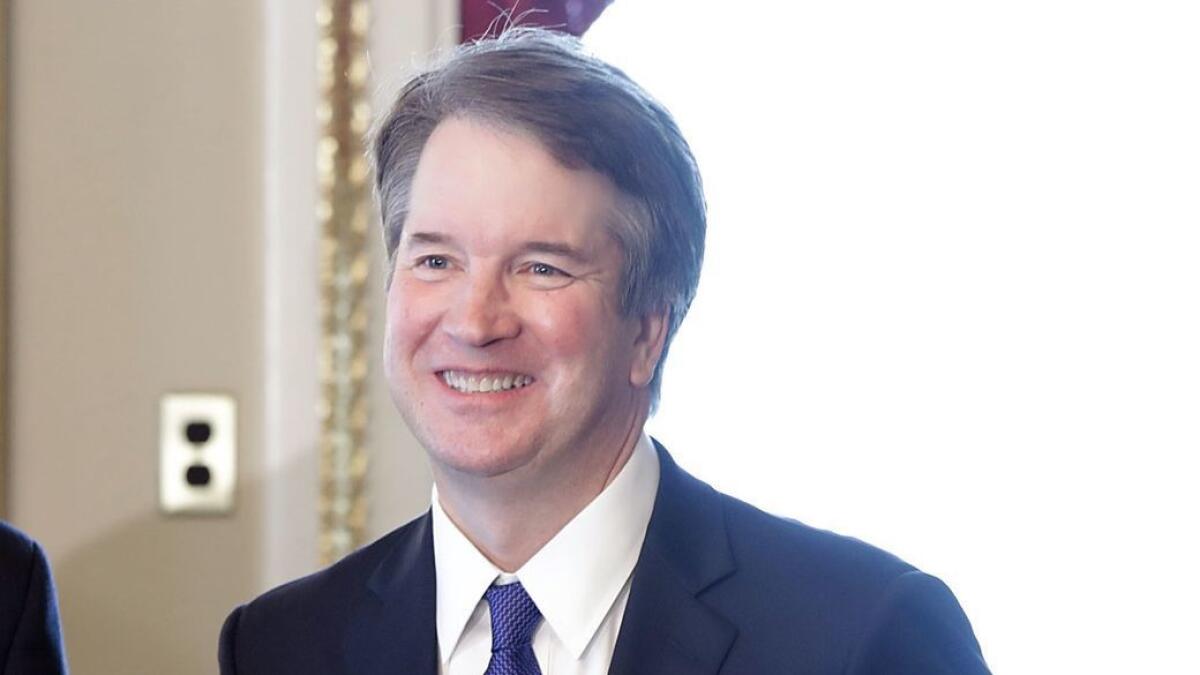Supreme Court nominee Brett Kavanaugh lauded late Chief Justice Rehnquist for dissenting in Roe vs. Wade and supporting school prayer

- Share via
Reporting from Washington — Judge Brett M. Kavanaugh, President Trump’s Supreme Court nominee, gave a revealing speech last fall in which he lauded former Chief Justice William H. Rehnquist for having dissented in Roe vs. Wade and for rejecting the notion of “a wall of separation between church and state.”
He also praised the late chief justice’s unsuccessful effort to throw out the so-called “exclusionary rule,” which forbids police from using illegally obtained evidence.
All three of areas of law — abortion, religion and police searches — are likely to be in flux if Kavanaugh is confirmed and joins the high court this fall.
Kavanaugh’s comments are significant because they were in a speech, not a court opinion in which he was bound by precedent, said David S. Cohen, a law professor at Drexel University in Philadelphia.
“He is not writing as a judge. This is him telling us his own views. And while he doesn’t come out and say ‘the dissent is right,’ it is pretty clear he agrees with Rehnquist,” Cohen said. Agreeing with the dissent, however, would not necessarily mean that Kavanaugh would now vote to overturn a long-standing precedent.
In the speech, Kavanaugh said Rehnquist “was my first judicial hero,” noting that he started law school at Yale in 1987, a year after President Reagan had elevated Rehnquist to be chief justice. Rehnquist had been the court’s lone true conservative for many years, and Kavanaugh said he felt much the same at Yale.
“His opinions made a lot of sense to me. In class after class, I stood with Rehnquist. That often meant in the Yale Law School environment of the time that I stood alone. Some things don’t change,” he said at a Constitution Day address delivered at the American Enterprise Institute in Washington in September 2017.
He cited five areas—“criminal procedure, religion, federalism, unenumerated rights and administrative law” — where Rehnquist stood fast against the liberals and moved the law to the right.
He “would be the first to say that he did not achieve full success on all the issues he cared about. But it is undeniable, I think, that he brought about a massive change in constitutional law and how we think about the Constitution,” Kavanaugh said.
Kavanaugh noted that Rehnquist joined the high court in 1972, only a few months before the justices heard a challenge to a Texas law that made all abortions a crime, except those done to save the life of the mother. In Roe vs. Wade, along with Justice Byron R. White, Rehnquist “ultimately dissented from the court’s 7-2 holding recognizing a constitutional right to abortion,” Kavanaugh said.
The Bill of Rights did not include an explicit right to abortion, and Rehnquist believed a new, “unenumerated” right should gain constitutional status only if it was “rooted into the traditions and conscience of our people. Given the prevalence of abortion regulations both historically and at the time, Rehnquist said he could not reach such a conclusion about abortion,” he said.
Rehnquist’s dissent in Roe vs. Wade said “the states had the power to legislate with regard to this matter,” he added.
Later, as chief justice, Rehnquist tried, but failed by one vote, to overrule the abortion decision in the 1992 case of Planned Parenthood vs. Casey. Kavanaugh did not mention it, but Justice Anthony M. Kennedy cast a decisive vote to preserve the right to abortion in that case.
“It is fair to say that Justice Rehnquist was not successful in convincing a majority of justices in the context of abortion, either in Roe itself or in later cases such as Casey,” Kavanaugh said. “But he was successful in stemming the general tide of free-wheeling judicial creation of unenumerated rights that were not rooted in the nation’s history and tradition.”
As an example, he cited the 1997 decision in Washington vs. Glucksberg, which rejected a right to assisted suicide for those who are terminally ill.
Turning to religion, Kavanaugh said Rehnquist had maintained that the “wall of separation between church and state” was a misleading metaphor “based on bad history.”
Thomas Jefferson as president used this phrase in a letter in 1802 to describe the 1st Amendment’s twin clauses — one banning an “establishment of religion” and other protecting the “free exercise” of religion. The Supreme Court adopted the metaphor in a 1947 opinion.
Scholars and judges have continued to disagree over whether the Constitution should be interpreted to forbid religious symbols on government property or religious invocations at government meetings.
As chief justice, Rehnquist failed to win a majority to uphold prayers and invocations at public school events, mostly because of Justice Kennedy, who cast crucial votes with the court’s liberals to reject prayers at school in 1992 and 1999.
“Rehnquist was central in changing the jurisprudence and convincing the court that the wall metaphor was wrong as a matter of law and history,” Kavanaugh said.
“Throughout his tenure and to this day,” he added, the court has “sought to cordon off public schools from state-sponsored religious prayers. But Rehnquist had much more success in ensuring that religious schools and religious institutions could participate as equals in society and in state benefit programs.”
In 2002, he noted, Rehnquist wrote the court’s opinion upholding a state law that gave parents tax money to pay for sending their children to religious schools. And just last year, the court upheld a Missouri church’s claim that it had a right to receive state funds to pay for a new school playground. “There again, the Rehnquist legacy was at work,” Kavanaugh said.
As Kavanaugh said, Rehnquist was most interested in criminal cases.
He “fervently believed the Supreme Court had taken a wrong turn in the 1960s and 1970s… in a number of sweeping rulings of the Warren Court” that expanded rights for criminal defendants, Kavanaugh said. He cited as examples the 1961 decision in Mapp vs. Ohio, which called for excluding evidence that arose from an illegal search, and the 1966 decision in Miranda vs. Arizona, which said police must warn suspects of their right to remain silent and to consult with a lawyer.
“Perhaps his most vehement objection… concerned the exclusionary rule,” Kavanaugh said. “This judge-created rule, in Rehnquist’s view, was beyond the four corners of the 4th Amendment’s text and imposed tremendous costs on society.” He did not succeed in overruling it, Kavanaugh noted, and not many are calling for a change today, “given its firmly entrenched position in American law.”
Nonetheless, he said, “Rehnquist dramatically changed the law of the exclusionary rule” in a 1984 ruling that said evidence should not be excluded if the police relied in “good faith” on a flawed search warrant.
In 2009, four years after Rehnquist died, the court did not overturn the exclusionary rule but came close. By a 5-4 vote in Herring vs. United States, the justices upheld evidence from an illegal police stop in Alabama. Chief Justice John G. Roberts Jr., a former law clerk for Rehnquist, said evidence from an illegal search should not be excluded unless the police misconduct was “deliberate, reckless or grossly negligent.” Justice Kennedy was in the majority after indicating earlier that he was unwilling to overturn the entire exclusionary rule.
More stories from David G. Savage »
Twitter: DavidGSavage
More to Read
Get the L.A. Times Politics newsletter
Deeply reported insights into legislation, politics and policy from Sacramento, Washington and beyond. In your inbox three times per week.
You may occasionally receive promotional content from the Los Angeles Times.











